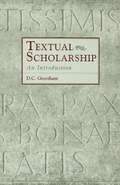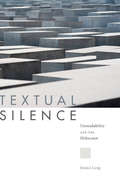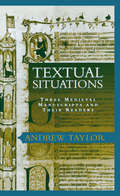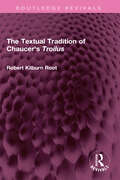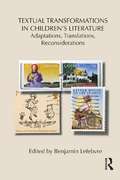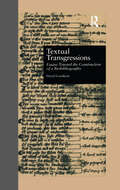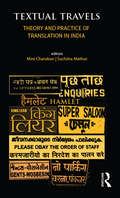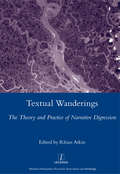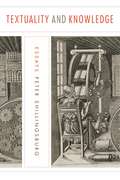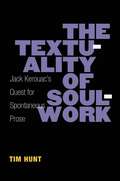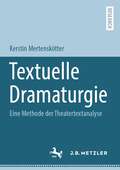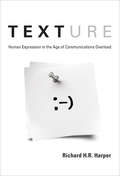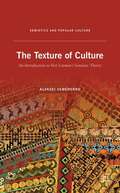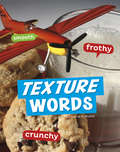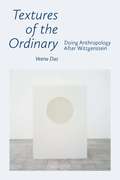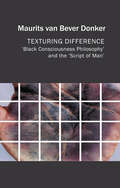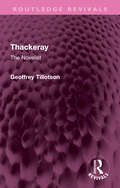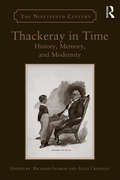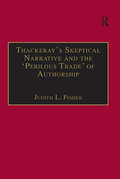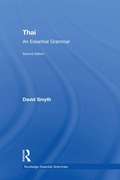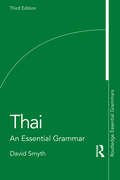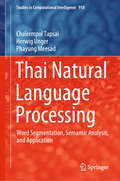- Table View
- List View
Textual Scholarship: An Introduction
by David GreethamThis fully revised and updated edition of the bestselling "Textual Scholarship" covers all aspects of textual theory and scholarly editing for students and scholars. As the definitive introduction to the skills of textual scholarship, the new edition addresses the revolutionary shift from print to digital textuality and subsequent dramatic changes in the emphasis and direction of textual enquiry.
Textual Silence: Unreadability and the Holocaust
by Jessica LangThere are thousands of books that represent the Holocaust, but can, and should, the act of reading these works convey the events of genocide to those who did not experience it? In Textual Silence, literary scholar Jessica Lang asserts that language itself is a barrier between the author and the reader in Holocaust texts—and that this barrier is not a lack of substance, but a defining characteristic of the genre. Holocaust texts, which encompass works as diverse as memoirs, novels, poems, and diaries, are traditionally characterized by silences the authors place throughout the text, both deliberately and unconsciously. While a reader may have the desire and will to comprehend the Holocaust, the presence of “textual silence” is a force that removes the experience of genocide from the reader’s analysis and imaginative recourse. Lang defines silences as omissions that take many forms, including the use of italics and quotation marks, ellipses and blank pages in poetry, and the presence of unreliable narrators in fiction. While this limits the reader’s ability to read in any conventional sense, these silences are not flaws. They are instead a critical presence that forces readers to acknowledge how words and meaning can diverge in the face of events as unimaginable as those of the Holocaust.
Textual Situations: Three Medieval Manuscripts and Their Readers (Material Texts)
by Andrew TaylorGenerations of scholars have meditated upon the literary devices and cultural meanings of The Song of Roland. But according to Andrew Taylor not enough attention has been given to the physical context of the manuscript itself. The original copy of The Song of Roland is actually bound with a Latin translation of the Timaeus.Textual Situations looks at this bound volume along with two other similarly bound medieval volumes to explore the manuscripts and marginalia that have been cast into shadow by the fame of adjacent texts, some of the most read medieval works. In addition to the bound volume that contains The Song of Roland, Taylor examines the volume that binds the well-known poem "Sumer is icumen in" with the Lais of Marie de France, and a volume containing the legal Decretals of Gregory IX with marginal illustrations of wayfaring life decorating its borders.Approaching the manuscript as artifact, Textual Situations suggests that medieval texts must be examined in terms of their material support—that is, literal interpretation must take into consideration the physical manuscript itself in addition to the social conventions that surround its compilation. Taylor reconstructs the circumstances of the creation of these medieval bound volumes, the settings in which they were read, inscribed, and shared, and the social and intellectual conventions surrounding them.
The Textual Tradition of Chaucer's Troilus (Routledge Revivals)
by Robert Kilburn RootFirst published in 1916, The Textual Tradition of Chaucer’s Troilus compares the best unprinted manuscripts of Chaucer’s Troilus with the printed texts. The purpose of the volume is to evaluate eighteen manuscripts, to determine so far as may be their relation to one another and to Chaucer’s original, and to show how they are to be used for the establishing of a critical text. This book will be of interest to students of literature, linguistics and history.
Textual Transformations in Children's Literature: Adaptations, Translations, Reconsiderations (Children's Literature and Culture #87)
by Benjamin LefebvreThis book offers new critical approaches for the study of adaptations, abridgments, translations, parodies, and mash-ups that occur internationally in contemporary children’s culture. It follows recent shifts in adaptation studies that call for a move beyond fidelity criticism, a paradigm that measures the success of an adaptation by the level of fidelity to the "original" text, toward a methodology that considers the adaptation to be always already in conversation with the adapted text. This book visits children’s literature and culture in order to consider the generic, pedagogical, and ideological underpinnings that drive both the process and the product. Focusing on novels as well as folktales, films, graphic novels, and anime, the authors consider the challenges inherent in transforming the work of authors such as William Shakespeare, Charles Perrault, L.M. Montgomery, Laura Ingalls Wilder, and A.A. Milne into new forms that are palatable for later audiences particularly when—for perceived ideological or political reasons—the textual transformation is not only unavoidable but entirely necessary. Contributors consider the challenges inherent in transforming stories and characters from one type of text to another, across genres, languages, and time, offering a range of new models that will inform future scholarship.
Textual Transgressions: Essays Toward the Construction of a Biobibliography
by David GreethamFirst published in 1998. Routledge is an imprint of Taylor & Francis, an informa company.
Textual Travels: Theory and Practice of Translation in India
by Mini Chandran Suchitra MathurThis book presents a comprehensive account of the theory and practice of translation in India in combining both its functional and literary aspects. It explores how the cultural politics of globalization is played out most powerfully in the realm of popular culture, and especially the role of translation in its practical facets, ranging from the fields of literature and publishing to media and sports.
Textual Wanderings: The Theory and Practice of Narrative Digression
by Rhian Atkin"Digression is a crucial motif in literary narratives. It features as a key characteristic of fictional works from Cervantes and Sterne, to Proust, Joyce and Calvino. Moving away from a linear narrative and following a path of associations reflects how we think and speak. Yet an author's inability to stick to the point has often been seen to detract from a work of literature, somehow weakening it. This wide-ranging and timely volume seeks to celebrate narrative digressions and move towards a theoretical framework for studying the meanderings of literary texts as a useful and valuable aspect of literature. Essays discussing some of the possibilities for approaching narrative digression from a theoretical perspective are complemented with focused studies of European and American authors. As a whole, the book offers a broad and varied view of textual wanderings."
Textuality and Knowledge: Essays (Penn State Series in the History of the Book #27)
by Peter ShillingsburgIn literary investigation all evidence is textual, dependent on preservation in material copies. Copies, however, are vulnerable to inadvertent and purposeful change. In this volume, Peter Shillingsburg explores the implications of this central concept of textual scholarship.Through thirteen essays, Shillingsburg argues that literary study depends on documents, the preservation of works, and textual replication, and he traces how this proposition affects understanding. He explains the consequences of textual knowledge (and ignorance) in teaching, reading, and research—and in the generous impulses behind the digitization of cultural documents. He also examines the ways in which facile assumptions about a text can lead one astray, discusses how differing international and cultural understandings of the importance of documents and their preservation shape both knowledge about and replication of works, and assesses the dissemination of information in the context of ethics and social justice. In bringing these wide-ranging pieces together, Shillingsburg reveals how and why meaning changes with each successive rendering of a work, the value in viewing each subsequent copy of a text as an original entity, and the relationship between textuality and knowledge.Featuring case studies throughout, this erudite collection distills decades of Shillingsburg’s thought on literary history and criticism and appraises the place of textual studies and scholarly editing today.
Textuality and Knowledge: Essays (Penn State Series in the History of the Book)
by Peter ShillingsburgIn literary investigation all evidence is textual, dependent on preservation in material copies. Copies, however, are vulnerable to inadvertent and purposeful change. In this volume, Peter Shillingsburg explores the implications of this central concept of textual scholarship.Through thirteen essays, Shillingsburg argues that literary study depends on documents, the preservation of works, and textual replication, and he traces how this proposition affects understanding. He explains the consequences of textual knowledge (and ignorance) in teaching, reading, and research—and in the generous impulses behind the digitization of cultural documents. He also examines the ways in which facile assumptions about a text can lead one astray, discusses how differing international and cultural understandings of the importance of documents and their preservation shape both knowledge about and replication of works, and assesses the dissemination of information in the context of ethics and social justice. In bringing these wide-ranging pieces together, Shillingsburg reveals how and why meaning changes with each successive rendering of a work, the value in viewing each subsequent copy of a text as an original entity, and the relationship between textuality and knowledge.Featuring case studies throughout, this erudite collection distills decades of Shillingsburg’s thought on literary history and criticism and appraises the place of textual studies and scholarly editing today.
The Textuality Of Soulwork: Jack Kerouac's Quest For Spontaneous Prose
by Timothy HuntTim Hunt’s The Textuality of Soulwork: Jack Kerouac’s Quest for Spontaneous Prose examines Kerouac’s work from a new critical perspective with a focus on the author’s unique methods of creating and working with text. Additionally, The Textuality of Soulwork delineates Kerouac’s development of “Spontaneous Prose” to differentiate the preliminary experiment of On the Road from the more radical experiment of Visions of Cody, and to demonstrate Kerouac’s transition from working within the textual paradigm of modern print to the textual paradigm of secondary orality. From these perspectives, Tim Hunt crafts a new critical approach to Beat poetics and textual theory, marking an important contribution to the current revival of Kerouac and Beat studies underway at universities in the U. S. and abroad, as reflected by a growing number of conferences, courses, and a renewal in scholarship.
The Textualization of the Greek Alphabet
by Roger D. Woodard David A. ScottIn this book, Roger D. Woodard argues that when the Greeks first began to use the alphabet, they viewed themselves as participants in a performance phenomenon conceptually modeled on the performances of the oral poets. Since a time older than Greek antiquity, the oral poets of Indo-European tradition had been called 'weavers of words' - their extemporaneous performance of poetry was 'word weaving'. With the arrival of the new technology of the alphabet and the onset of Greek literacy, the very act of producing written symbols was interpreted as a comparable performance activity, albeit one in which almost everyone could participate, not only the select few. It was this new conceptualization of and participation in performance activity by the masses that eventually, or perhaps quickly, resulted in the demise of oral composition in performance in Greece. In conjunction with this investigation, Woodard analyzes a set of copper plaques inscribed with repeated alphabetic series and a line of what he interprets to be text, which attests to this archaic Greek conceptualization of the performance of symbol crafting.
Textuelle Dramaturgie: Eine Methode der Theatertextanalyse
by Kerstin MertenskötterEin Blick in die aktuellen Spielpläne der Theater der Gegenwart offenbart ein offenes und hetero-genes Feld an Textformen und Inszenierungsweisen. Klassische Dramen und traditionelle Insze-nierungen finden sich neben postdramatischen Arbeiten und der Ästhetik der Neudramatik. Das Postdramatische Theater und ebensolche Texte, etwa von Elfriede Jelinek, Peter Handke oder René Pollesch stehen dabei im Kontext ihrer Aufkündigung mit dem „Dreigestirn von Drama, Handlung und Nachahmung“, wie Hans-Thies Lehmann es in seiner Monografie "Postdramatisches Theater" beschreibt. Dies führt zu einer Entpersonalisierung der Figuren, zu einer Monologisierung der Dialogstruktur, zu einem Bruch mit dem Anspruch auf kausal-logische Wiedergabe eines ‚Geschehens‘. Doch die an der aristotelischen Poetik und dem Drama des 18. Jahrhunderts ausgerichtete Methode der Dramenanalyse kann (aktuelle) Theatertexte, die ohne Handlung und Figuren auskommen, nicht oder nur ex negativo erfassen. Kerstin Mertenskötter entwickelt eigene, erweiterte und revidierte literaturwissenschaftliche Analysebegriffe. Die Methode der Theatertextanalyse ermöglicht es, sowohl einen produktiven analytischen Zugang zu post- und neudramatischen Theatertexten zu erlangen, wie auch dramaturgische Verfahren in Theatertexten des 18. und 19. Jahrhunderts zu entdecken.
Texture: Human Expression in the Age of Communications Overload (The\mit Press Ser.)
by Richard H. HarperWhy we complain about communication overload even as we seek new ways to communicate.Our workdays are so filled with emails, instant messaging, and RSS feeds that we complain that there's not enough time to get our actual work done. At home, we are besieged by telephone calls on landlines and cell phones, the beeps that signal text messages, and work emails on our BlackBerrys. It's too much, we cry (or type) as we update our Facebook pages, compose a blog post, or check to see what Shaquille O'Neal has to say on Twitter. In Texture, Richard Harper asks why we seek out new ways of communicating even as we complain about communication overload.Harper describes the mistaken assumptions of developers that “more” is always better and argues that users prefer simpler technologies that allow them to create social bonds. Communication is not just the exchange of information. There is a texture to our communicative practices, manifest in the different means we choose to communicate (quick or slow, permanent or ephemeral).
The Texture of Culture
by Aleksei SemenenkoIn this introduction to the semiotic theory of one of the most innovative theorists of the twentieth century, the Russian literary scholar and semiotician Yuri Lotman, offers a new look at Lotman's profound legacy by conceptualizing his ideas in modern context and presenting them as a useful tool of cultural analysis.
Texture Words (Word Play)
by Carrie B. SheelyFluffy. Soft. Scaly. Kids encounter many textures in everyday life. Bring texture words to young learners, and watch their vocabularies grow! Words are carefully matched to engaging photos that will keep children captivated from beginning to end.
Textures of the Ordinary: Doing Anthropology after Wittgenstein (Thinking from Elsewhere)
by Veena DasHow might we speak of human life amid violence, deprivation, or disease so intrusive as to put the idea of the human into question? How can scholarship and advocacy address new forms of war or the slow, corrosive violence that belie democracy's promise to mitigate human suffering? To Veena Das, the answers to these question lie not in foundational ideas about human nature but in a close attention to the diverse ways in which the natural and the social mutually absorb each other on a daily basis. Textures of the Ordinary shows how anthropology finds a companionship with philosophy in the exploration of everyday life. Based on two decades of ethnographic work among low-income urban families in India, Das shows how the notion of texture aligns ethnography with the anthropological tone in Wittgenstein and Cavell, as well as in literary texts. Das shows that doing anthropology after Wittgenstein does not consist in taking over a new set of terms such as forms of life, language games, or private language from Wittgenstein’s philosophy. Instead, we must learn to see what eludes us in the everyday precisely because it is before our eyes. The book shows different routes of return to the everyday as it is corroded not only by catastrophic events but also by repetitive and routine violence within everyday life itself. As an alternative to normative ethics, this book develops ordinary ethics as attentiveness to the other and as the ability of small acts of care to stand up to horrific violence.Textures of the Ordinary offers a model of thinking in which concepts and experience are shown to be mutually vulnerable. With questions returned to repeatedly throughout the text and over a lifetime, this book is an intellectually intimate invitation into the ordinary, that which is most simple yet most difficult to perceive in our lives.
Texturing Difference: "Black Consciousness Philosophy" and the "Script of Man" (Critical South)
by Maurits van Bever DonkerThis book situates the nuanced intervention of the Black Consciousness Movement in South Africa within the international conjuncture of anti-colonial thought and decolonization. It argues that the Black Consciousness Movement, in addition to its urgent political focus, should also be read as a philosophical intervention on the problem of Man that haunts the idea of race. As Steve Biko once famously said, apartheid will end; the real question is what comes after apartheid. Maurits van Bever Donker argues that the Black Consciousness Movement found intellectual and conceptual allies in the writings of Frantz Fanon and Aimé Césaire, tracing the problem of race as foundational to what is called ‘the script of Man’ and, in the process, inventing the possibility of a new sense of Man, one with ‘a more human face’. While the work of figures like Biko, Fanon and Césaire tends to be read as discrete political texts in a broader field of negritude and radical black thought, Texturing Difference explores what becomes possible when this network of texts is read from the perspective of South Africa. This intervention has significance, not only for how race is approached and understood in South Africa, but for the global workings of race in our time.
Thackeray: The Novelist (Routledge Revivals)
by Geoffrey TillotsonFirst published in 1954, Thackeray is intended as a reminder that Thackeray is, after all, a great novelist. Professor Tillotson, admiring the novels as great literature, explores their common characteristics and those they share with the rest of Thackeray’s writings – for he sees Thackeray’s work as all of a piece. He is particularly interested in Thackeray’s methods of narration and in the philosophic commentary which forms a sort of trellis for almost everything he put out. He sees him mainly as a writer who, subtle as he is, address himself to readers honoured as ordinary human beings. In two appendices, Professor Tillotson deals with two particular modern opinions – that Thackeray spoiled his novels by an ‘infiltration’ into them of his own biography, and that he has no place in the great novel tradition. This book will be of interest to students of literature and history.
Thackeray in Time: History, Memory, and Modernity (The Nineteenth Century Series)
by Richard Salmon Alice CrossleyAn intense fascination with the experience of time has long been recognised as a distinctive feature of the writing of William Makepeace Thackeray (1811–1863). This collection of essays, however, represents the first sustained critical examination of Thackeray's 'time consciousness' in all its varied manifestations. Encompassing the full chronological span of the author's career and a wide range of literary forms and genres in which he worked, Thackeray in Time repositions Thackeray's temporal and historical self-consciousness in relation to the broader socio-cultural contexts of Victorian modernity. The first part of the collection focusses on some of the characteristic temporal modes of professional authorship and print culture in the mid-nineteenth century, including periodical journalism and the Christmas book market. Secondly, the volume offers fresh approaches to Thackeray's acknowledged status as a major exponent of historical fiction, reconsidering questions of historiography and the representation of place in such novels as Vanity Fair and Henry Esmond. The final part of the collection develops the central Thackerayan theme of memory within four very different but complementary contexts. Thackeray's absorption by memories of childhood in later life leads on to his own subsequent memorialisation by familial descendants and to the potential of digital technology for preserving and enhancing Thackeray's print archive in the future, and finally to the critical legacy perpetuated by generations of literary scholars since his death.
Thackeray’s Skeptical Narrative and the ‘Perilous Trade’ of Authorship (The Nineteenth Century Series)
by Judith L. FisherDrawing on the rhetorical work of James Phelan, Wayne Booth's ethical criticism, recent work on William Makepeace Thackeray, as well as an understanding of the role of skepticism in eighteenth- and nineteenth-century English thought, Thackeray's Skeptical Narrative and the "Perilous Trade" of Authorship makes a substantial contribution to nineteenth-century reading practices, as well as narratology in general. Judith Fisher combines in this study rhetorical and ethical analysis of Thackeray's narrative techniques to trace how his fiction develops to educate his reader into what she terms a "hermeneutic of skepticism." This is a kind of poised reading which enables his readers to integrate his fiction into their life in what Thackeray called "a world without God" without becoming pessimistic or fatalistic. Although Thackeray's narrative strategies have been the subject of study, most have focused on Vanity Fair and Henry Esmond only, and none look as closely as does this study at actual rhetorical techniques such as his use of pronominalization to interpolate the reader into his skeptical discourse. Fisher also brings her analysis to bear on The Adventures of Philip and The Virginians, Thackeray's last two complete novels, both of which were critical failures even as contemporary critics acknowledged their stylistic excellence. This is the first study to attempt to understand the puzzle of those two books; Fisher recovers them from their marginalized position in Thackeray's oeuvre. Fisher expertly weaves an accessible narrative theory with thoroughgoing knowledge of Thackeray's life in an integrated reading of his entire works. Reading Thackeray holistically in spite of his own disruptive practices, she does full justice to his critical skepticism while elucidating his canon for a new readership.
Thai: An Essential Grammar (Routledge Essential Grammars)
by David SmythThis second edition of Thai: An Essential Grammar provides an up-to-date and concise reference guide to Thai grammar. Using clear, jargon-free explanations, it sets out the complexities of Thai in short, readable sections and presents an accessible description of the language. Focus is kept on the real patterns of use today and grammar forms are demonstrated through a wide range of relevant examples. No prior knowledge is assumed on the part of the reader. Features include: Coverage of crucial topics, such as sentence particles, negation, questions and quantification Examples given in both Thai script and romanised transliteration Pronunciation section Guidance on speech conventions and the Thai writing system Glossary of grammatical terms Two appendices covering Romanisation systems and three key verbs Bibliography This unique reference work will prove invaluable to all learners looking to master the grammar of Thai. It is ideal either for independent study or for students in schools, colleges, universities and adult classes of all types.
Thai: An Essential Grammar (Routledge Essential Grammars)
by David SmythThis third edition of Thai: An Essential Grammar provides an up-to-date and concise reference guide to Thai grammar.Using clear, jargon-free explanations, it sets out the complexities of Thai in short, readable sections and presents an accessible description of the language. Focus is kept on the real patterns of use today and grammar forms are demonstrated through a wide range of relevant examples. No prior knowledge is assumed on the part of the reader.Features include: coverage of crucial topics, such as sentence particles, negation, questions and quantification examples given in both Thai script and romanised transliteration pronunciation section guidance on speech conventions and the Thai writing system glossary of grammatical terms two appendices covering romanisation systems and three key verbs bibliography This unique reference work will prove invaluable to all learners looking to master the grammar of Thai. It is ideal for both independent study and for students in schools, colleges, universities and adult classes of all types.
Thai Natural Language Processing: Word Segmentation, Semantic Analysis, and Application (Studies in Computational Intelligence #918)
by Chalermpol Tapsai Herwig Unger Phayung MeesadThis book presents comprehensive solutions for readers wanting to develop their own Natural Language Processing projects for the Thai language. Starting from the fundamental principles of Thai, it discusses each step in Natural Language Processing, and the real-world applications. In addition to theory, it also includes practical workshops for readers new to the field who want to start programming in Natural Language Processing. Moreover, it features a number of new techniques to provide readers with ideas for developing their own projects. The book details Thai words using phonetic annotation and also includes English definitions to help readers understand the content.
Thalia Delighting in Song
by Bonnie Maclachlan Emmet I. RobbinsEmmet I. Robbins earned an international reputation as a scholar of ancient Greek poetry, possessing a broad cultural background and a command of many languages that allowed him to present sensitive and informed readings of poets from Homer to the tragedians. Thalia Delighting in Song assembles for the first time his work from 1975 through 1999, reflecting his close reading of the Greek texts and his firm grasp of their literary, historical and mythological contexts.Among the essays included in this volume are important reflections on the poetry of Homer, Alcman, Sappho, Pindar and Aeschylus. Also featured are Robbins' writings that situate Greek texts in their wider contexts, comparing Greek poetry and modern opera, for example, or assessing the enduring influence of myth in the Indo-European traditions, accounting for links between Greek literature and the poetry, sagas and songs of several other cultures. Thalia Delighting in Song ensures that the next generation of Classicists will continue to benefit from the insights of one of the foremost scholars in the field.
